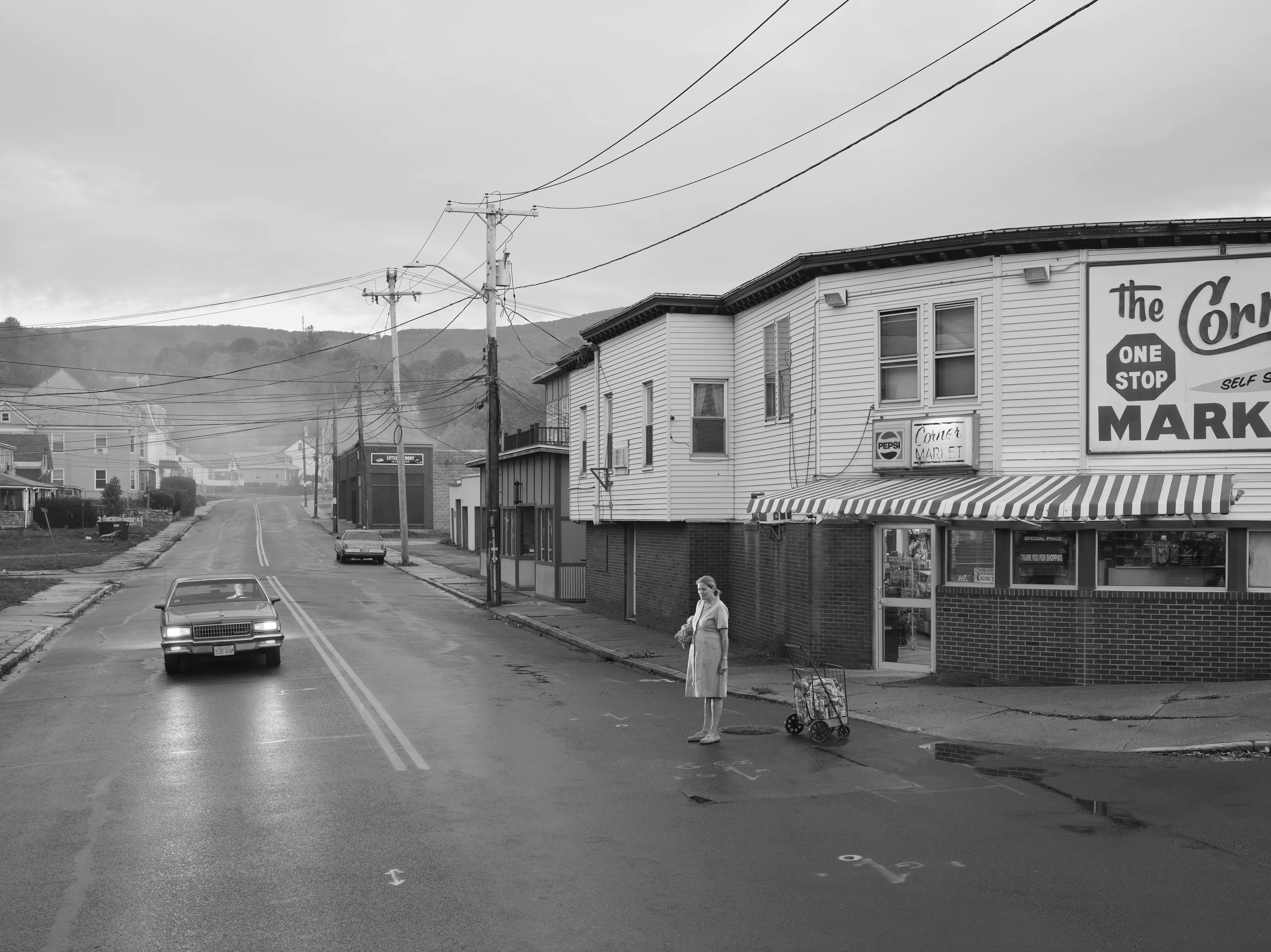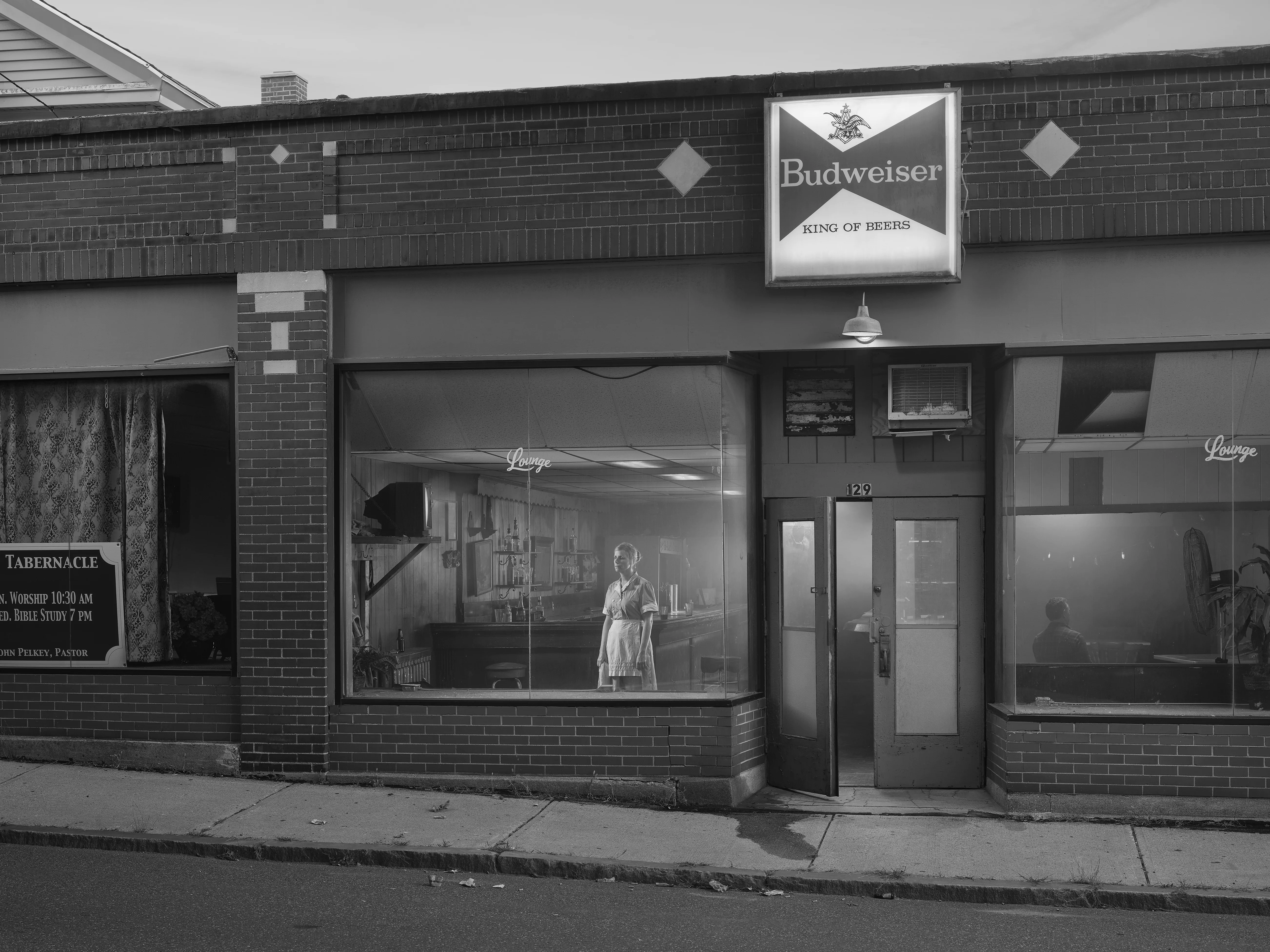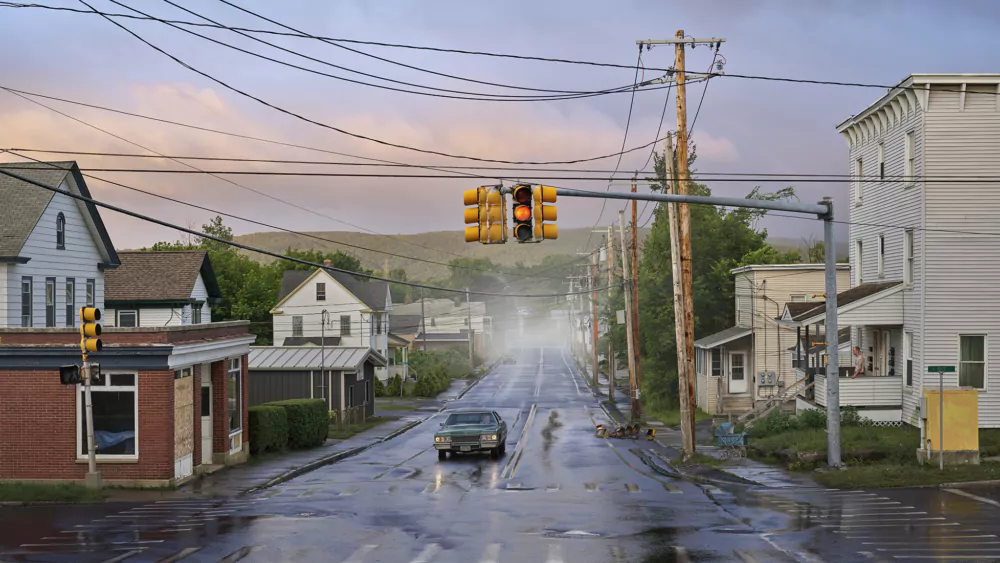
Gregory Crewdson in discussion with Bruce Bégout
The American photographer Gregory Crewdson and the French philosopher Bruce Bégout meet in the run-up to the artist’s exhibition at the Rencontres d’Arles, ‘Eveningside’, and discuss the creation of an atmosphere, the notion of the sublime, 18th century French painting, the influence of psychoanalysis, and Crewdson’s enduring fascination with the fixed image.
BB: Diferent contrasts run through your work.The first one would be between the complexity and richness of the technical setup – of the production of the photographs – and, on the other hand, the simplicity – banality even – of the scenes depicted. Have you ever considered using a simpler, more direct, more elemental technical process to capture these moments of everyday life which are the subject of your photographs?
GC: Well, at the core of it, I would consider myself to be a storyteller; I use still pictures in a way to try to capture some kind of mood or atmosphere using light and color and form.
Still photographs, unlike movies or other narrative forms, are frozen and mute, so for me the only way to make a narrative is through light, essentially.
That’s the key element in all the work, and I do try to create a kind of tension between very ordinary experience like something that feels familiar and then something that’s also transformed and feels elevated in some way, sort of subjective and beautiful and mysterious.

BB: What I notice in your work, in particular in Twilight or in An Eclipse of Moths, is the fact that the America you portray, which is an America of the margins, of small towns which have been left behind, seems frozen in the 60s, as if fundamentally these images occupy the role of childhood memories.
GC: I want the pictures to feel timeless, like something just out of our grasp in terms of specific place or time. So, I tend to use similar iconography; similar kinds of cars and streets, and costumes, all in an effort to create a world that is familiar but also kind of mysterious and outside of time.
At the same time, I want the pictures to feel relevant to the moment we’re in. I want them to remain outside of time but also be meaningful to where we are as a culture.
BB: You’ve mentioned on a number of occasions the role played by your father’s psychoanalytic practice in your artistic development, and in raising your awareness of hidden truths – of the underside of things which had been brushed under the carpet of normality. In fact, your works have a very strong dreamlike, even psychoanalytic quality. Have you read Freud and in particular his essay on the ‘Uncanny’, which seems almost to illustrate your work?
GC: It’s really interesting that you mention that because I have my father’s edition of the entire collection of Freud’s writing and I have the volume in my studio with the essay The Uncanny with all his original notes in it, which is one of my very precious books. And indeed, almost by happenstance that book kind of directly connects to every single one of my pictures trying to locate a kind of sense of terror or mystery unexpectedly in everyday life. My father, when I was growing up, had his office in the basement of our house and so that was always, even on an unconscious level, an interest in what’s beneath the surface of things, the kind of secrets that exist just beneath the surface of domestic façades.

JIM’S HOUSE OF SHOES, 2021-2022, framed archival pigment print mounted to dibond, 87 × 117 cm – 34 ½ × 46 in (102 × 132 cm- 40 ½ × 52 in framed), edition of 6 + 3 AP
BB: So, to further develop that point, do you consider your images – your works, as a sort of therapeutic process which works through images rather than words?
GC: I absolutely think there’s a kind of psychological element to the work but I think it’s also important to separate the psychology of the picture from the maker. There is a connection but I don’t believe my pictures are autobiographical in any sort of literal sense. They hold within them my own kind of obsessions and preoccupations, my fears and desires so they are definitely psychological in nature.
BB: What also astonishes me with your photography is the relationship which is fundamentally between three elements: characters, landscape, and action. Often when looking at your images we get the impression that you’re not representing an action but rather the moment directly after. It’s not the disaster that you’re interested in but the state of awe, of astonishment, in the aftermath of the disaster.
GC: My pictures seem to be kind of caught between before and after. There’s very little that’s actually happening in any of the pictures, so, either something just happened or something’s about to happen, but never happening. According to me part of the strength of photography as opposed to other narrative forms is that there is this great inbetweenness; it’s very hard to capture continuity in a picture, or plot, or any kind of traditional story because you only have this one moment. Rather than trying to make it about something, I want it to be about a kind of quiet, private revelation of something; some small thing that’s magnified by the form of the pictures, by the place, as you said about the relationship between the figure and the space.
Setting is so important. The landscape is so important. All these things are part of what motivates the pictorial experience.

BB: I’d like to focus on the attitude of the characters in most of your photos, who often seem immobilized, dumbstruck, and almost prostrate. In a book on 18th century French painting, Michael Fried, who you know perhaps as an art theorist, wrote about an attitude of absorption – of immersion on the part of characters, for example in Jean-Baptiste Greuze, Jean Siméon Chardin, or Charles André van Loo. But these were characters engrossed in a task, an activity, in what they are doing. Whereas the characters in your photographs are just as absorbed. Here the sense is in fact that these characters are waiting for something impossible to define, rather like the characters in the plays by the Irish, or French, dramatist Samuel Beckett. Is this emptiness conveyed by the characters some kind of expectation? Or paralysis?
GC: That’s a good question! First of all, I really love your read on it and the reference to Michael Fried and theatricality and absorption; it’s something that definitely influenced me when I was a younger artist coming of age.
I think that’s, to me, what the still image is really great at because it’s not good as a literal narrative… When I’m working with the people in the pictures, I always tell them I want less, emptied out. Almost nothing is what I really desire in the picture because it just makes it more of a kind of mystery or question mark. I don’t like any literal actions or answers in the picture, I want it to kind of remain kind of unresolved. That the viewer brings their own meaning to the pictures.
BB: Returning to my first question on contrast, in your images there is a very strong contrast between people lost in themselves and the immensity of an urban, or natural, landscape which seems indifferent to them. Often, these scenes are situated in the American suburbia, and in particular in what Nan Goldin calls the ‘suffocating trap of the suburbs’.
What is so fascinating about the American suburbs that means that all these great American artists – John Cheever, Raymond Carver, Stephen Shore, Tod Hido, David Lynch – are obsessed with representing this ‘suffocating trap’?
GC: Well, I can’t speak for them. But admire all their work. Let me say that photography, the medium itself, has a kind of alienation to it – just looking through a lens. You’re always separated from the world that you’re in. I love the idea of these isolated figures, in a very ordinary landscape that feels familiar, searching for something outside of themselves, trying to make a connection in the world.
There is this long-time tradition of artists working in ordinary life and looking for some kind of theatrical moment. It is not only alienating but there’s also something that’s potentially beautiful about it.
To me, my first ambition, always, is to try to make the most beautiful picture I can.
And I believe a lot of artists who are working in this terrain also feel that way. Even though there’s a criticality to it and an alienation, and a discontent, there is also something beautiful about a Stephen Shore picture or a Tod Hido picture. Something appears ordinary and beautiful at the same time; both normal and paranormal. Something about nature and domesticity; something about fiction and reality. All these tensions come together to create meaning.

MADELINE’S BEAUTY SALON, 2021-2022, framed archival pigment print mounted to dibond, 87 × 117 cm – 34 ½ × 46 in (102 × 132 cm- 40 ½ × 52 in framed), edition of 6 + 3 AP
BB: You talk about beauty but what seems more characteristic of your work is in fact that you treat ordinary life as something sublime. And precisely what is striking is that the trivial, banal aspect is treated like something sublime. It’s as though it were, for instance, a grand landscape or a great historical battle painting from the 18th century, but this treatment is deployed for small, insignificant occurrences.
GC: I love that use of the word sublime because it’s not only beauty but there’s also a sense of terror in it. Something kind of looming, some sense of possible collapse or – the apocalypse of some sort. Definitely the sublime is something that I’ve always been interested in and influenced by.
BB: One thing that often comes up in discussion of your work is your ability to create atmospheres: troubling, strange, and bizarre atmospheres. Yet atmosphere is something which is often difficult to grasp, it’s something floating and subtle. So, I’d like to know how, with such a considerable and complex technical setup, you manage to produce something as fragile and evanescent as atmosphere. How do you manage to create an atmosphere? Do you feel like you always succeed?
GC: In terms of atmosphere, that’s what it’s all about for me: to create a mood. We do that through lighting and fog machines, and wet-downs, and various other things.
That is all part of it – trying to create an image that feels like it’s another world. To try to capture that is very difficult and it does work you can see it right in front of you. You can see it happening on set – you can see it all coming together. To me, that’s the most beautiful part of the whole experience: making all of that come together in a beautiful way.
BB: It is often rightly said that your work has a cinematic quality. How come you’ve never made the jump into filmmaking when so many artists, painters, or photographers, have taken this step towards cinema and you, as far as I can tell, never have?
GC: Well, Juliane Hiam and I have been working on a project in private. I organically think in terms of still images so, if we ever made this it would be a real challenge.

ALONE-STREET, 2018-2019, framed archival pigment print mounted to dibond, 145 × 243 × 5 cm — 57 1/8 × 95 2/3 × 1 1 in, edition of 4 + 2AP
_
‘Gregory Crewdson. Eveningside – 2012-2022’, Les Rencontres de la photographie, La Mécanique Générale, Arles, France, from July 3 to September 23, 2023. Curator: Jean-Charles Vergne.
Bruce Bégout is a writer and philosopher. Former student of the ENS-Ulm, and professor of philosophy at the University of Bordeaux. His work focuses on the phenomenology of everyday life, the contemporary urban world and atmospheres. Latest publications: Le concept d’ambiance (Seuil, 2020), Obsolescence des ruines (Inculte, 2022), Notre douloureux présent (Mémoires des annales de phénoménologie, 2023).
